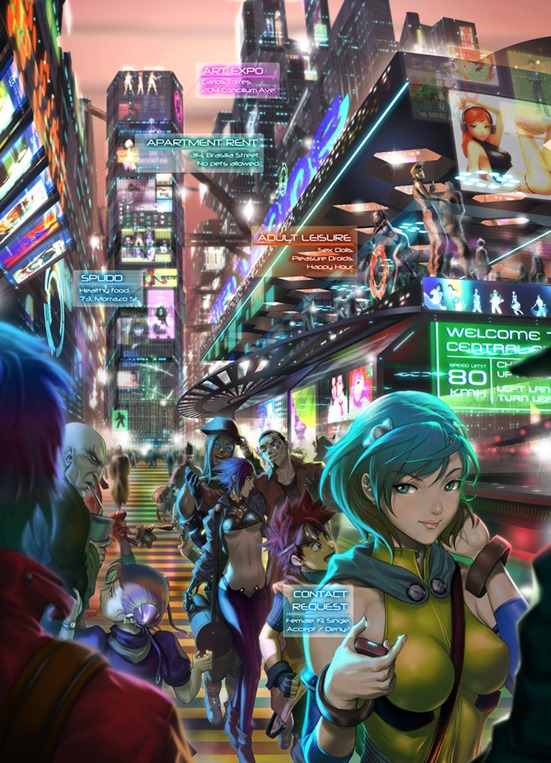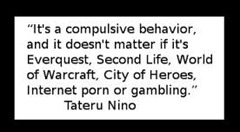Lessons from the Metaverse
I’ve been doing a lot of contemplation lately concerning the emergent nature of... well, I suppose everything. When I look back at the history of virtual environments, it never ceases to amaze me how many times companies are caught off guard at the shear ingenuity of the end-user and community to filter and refine the initial genesis of an idea into something beyond their wildest dreams. What is reflected back by the community is like an amplified and far more amazing thing than the original programmers started with.
 Something I Lost – Richard Johnson
Something I Lost – Richard Johnson
This isn’t an observation of Linden Lab alone, but throughout many instances. Similarly this scenario has played out time and again whether it’s from the perspective of Active Worlds (and Worlds Online), right up to and including things like Minecraft.
When Worlds Inc had their internal development working on Alpha tech and Gamma tech as candidates for their next evolution in the Worlds Player, they didn’t see the merit in a completely open ended and user-generated virtual world. They had (and still to this day) bet on the publish model where things are pre-created and the end-users are merely consumers.
We see that publish model remaining persistent in the “Web as Future of VR” push today, which stands behind either proprietary engines and plugins or WebGL and HTML5. Though to be honest, this is nothing more than a rehash of the similar VR hype phase in the 90s that pushed the same exact thing – We called it either proprietary VRML plugins (Blaxxun Technologies) or just VRML/X3D as a standard for the web.
With Alphaworld separating from Worlds as its own company, Worlds fell to the wayside of its once elevated status dealing with the likes of David Bowie and Aerosmith in the 90s (now being patent trolls). Alphaworld eventually turned into ActiveWorlds and it too has fallen to the same issue of lack of foresight. Nearly 7 years ago my final words to them were that they needed to go to a freemium model focusing not on premium subscriptions but microtransactions. That was 7 years ago and they laughed when I said it, but fast forward to this year and that’s exactly what they’re doing, albeit many years late to the scene.
Second Life, likewise was originally designed as a game. It was after the end-users went buck wild with it for all sorts of purposes and uses that they never anticipated that the idea of “Metaverse” popped into their mind and Philip Rosedale jumped on the bandwagon as the “visionary” selling the dream.
Sure he was a bit of an opportunist in all of that (Johnny-Come-Lately), but at least he got on the bandwagon and sort of got the gist of it all. When I say “sort of” it’s because you really can’t jump on the Metaverse bandwagon with a system designed with centralized and game-type architecture. I would say he sorta got it right but the original lack of vision for what Second Life was supposed to be turned out to be the Achilles heel in the end.
AvatarReality (BlueMars) was a great idea, but executed poorly. Unfortunately, for a company throwing so much into using the Crytek Engine, they seemed to have forgotten the fate of the company they were mimicking – Worlds Inc.
BlueMars may as well have been a direct descendant of Worlds Player in the modern age. With a publish model, and having to pre-download worlds in advance before being able to enter them, they were essentially what I would have imagined Worlds Player to have been if they threw a Crytek engine at it.
It was a costly mistake to say the least, and despite repeated attempts to make this clear to them prior to their collapse, I was told that I was being paranoid and everything was doing great.
With Second Life we’ve essentially come full circle in the game vs. metaverse thinking. Rod Humble is (after all) a game executive, so to him anything that has a game engine looks like a game and will be treated as such. There’s no denying this in the aftermath and continuing issues with their ToS. Come hell or high water, they are going to weld Second Life to Desura whether you like it or not.
Obligatory Mini-Rant
As a content creator I’m incredibly pissed about this betrayal and absolute hostility for such an integral part of Second Life. The level of ignorance and contempt for the end-user it takes to do such a thing is astronomical. So much so that I’m not sure that I’ll ever trust or respect Linden Lab again going forward.
Coming from the guy that wrote the seminal publication on the Metaverse, I’d like to think that says a hell of a lot. It’s the best that I can do short of telling Rod Humble where to go. The ToS isn’t an accident... it’s a very deliberate, hostile and contemptuous piece of writing. It was uncalled for and it’s absolutely an insult to the last ten years of Second Life and every single content creator that made the virtual world what it is today.
Instead of going on indefinitely with a rant about it, I’m just going to leave it at that. When you show such contempt and hostility toward an entire population and act nonchalant about it, there isn’t an ounce of respect that they’re going to receive from me any longer. They simply don’t deserve it.
Lessons Learned
I’m easily distracted by red-heads. Pretend this is relevant to the section.
Knowing the history of virtual environments is both a blessing and a curse to me. When writing the paper for Association for Computing Machinery with Loyola Marymount University, I had to see the entirety of the history laid bare before me and then make observations for future research directions. It wasn’t easy for me, because I’m just as much (if not more) of an advocate for the Metaverse (with a capital M) than most. It was painful to see the wreckage left in the wake of twenty plus years in the industry, and to understand that most of it was completely avoidable.
What I learned from all of this is that there is always going to be an opportunistic group repackaging the past and selling it as the future. History continues to repeat itself with a new slogan and catchy buzzword. This isn’t limited to virtual worlds, because let’s face it – Hasbro re-released Laser Tag as if it was a new thing, Hollywood is obsessed with reboots and remakes, and the media industry is all but intellectually and imaginatively devoid at this point with a small handful of breakout hits which get beat to death and squeezed for every drop of commodity they can get out of it (see also Angry Birds).
With the Virtual Worlds Framework (open source) I see yet another VRML type wannabe unable to get traction, however much Lockheed Martin et al would like for it to be widely adopted. Even Cloud Party to me is a fad, though I’m sure nobody would want to hear that.
Of course, then there is OpenSim and related HyperGrid stuff, which is impressive for what it is, but again it follows the same scenario as all of the white label “universes” that ActiveWorlds spawned in 3rd Party existence during the 90s.
At the end of the day, I think even OpenSim is a stop-gap at best, and things like InWorldz, Kitely, AviNation, etc are various iterations of that (sort of like the Opera browser compared to Firefox or Chrome). Though I might be wrong about this later on... the future has yet to be written.
What I’ve learned from all of this enjoys the benefit of hindsight and careful observation of the industry all the way back to when Habitat existed in 1989.
The Metaverse is Emergent
 Imagination Series: A Book Before Bed
Imagination Series: A Book Before Bed
Most of what makes up a Metaverse are the emergent creations and sociological behaviors of the end-users when given the tools to create. What a company in this space needs to comprehend before they write a single line of code is that you’re not building a specific purpose driven product. If you look at the demographic appeal for virtual worlds (open ended sandbox) what you find is that it ranges from 18 - 45+ with a near even male and female split. If you’re a marketer looking at that information, you either have a meltdown from not being able to fit it into a narrow constraint (18-24 Male Hardcore Gamer) or you realize that what you’re looking at is the equivalent to the Master Sword of Demographic appeal. You could even extend that demographic back into the age 13 area if you were to put in proper age restrictions for content ahead of time.
What makes a Metaverse platform so appealing is specifically that there isn’t a defined purpose for it. In much the same way as you would equate being in charge of the World Wide Web – nobody can really narrow down the demographic appeal for the Internet as a whole or adequately describe all of the use case scenarios for it.
This is the first modern lesson we need to embrace out of the gate. If you know that the virtual world is agnostic and you’re just providing the tools to foster creation in an emergent fashion, then you’ll never be in a position where the company is effectively trying to replicate community services or creative processes. There is something to be said for understanding this very basic premise, and it’s an understanding that Linden Lab botched horribly with their Premium Account “added value” offerings.
Lesson: You will never predict the infinite number of use-cases and scenarios that your end-users will ultimately utilize the platform for. Don’t try to constrict the use-cases or define the virtual world for them. Just learn to foster creation and that digital evolution, letting the rest take care of itself.
In the words of Chip Morningstar and Randy Farmer: Work within the system. It’s a Zen thing... you are part of the whole, neither controlling nor subservient to it. A delicate ecosystem and balance that has widespread reach and effect for even the most simple of actions. What’s in their best interest is ultimately in your best interest as well. Poison them and you poison yourself in the process.
The Metaverse is Symbiotic
 SonicEther’s Unbelievable Shaders for Minecraft
SonicEther’s Unbelievable Shaders for Minecraft
The fastest way to find out if something is possible is to tell your community it’s impossible. Watch how fast they prove you wrong. Always celebrate the ingenuity and infinite creativity of your community. Cater to it whenever possible.
One should never assume the rights to content created by the community. If you want extra rights to that content, you should ask or put into place a method by which to properly negotiate that ability. Helping yourself to a mountain of content for resale, redistribution and far more is just sleazy.
It breaks the trust and the social contract you set into motion with your end-users who are in a symbiotic relationship with your virtual world. You need them just as much as they need you, and without each other the whole thing comes crashing down or wastes away becoming a shadow of its former self (just ask Worlds and ActiveWorlds).
Whenever I see any company try to assign themselves sweeping rights and licenses over content they don’t own, it makes me wonder if they really understand their interdependencies with the community that makes their virtual world possible, and it makes me wonder if that company even respects their end-users. It’s a very selfish and narrow minded thinking that pulls such a bait and switch maneuver.
Doing it wrong would obviously be the case of Linden Lab and their ToS situation. But there exists a brilliant case where a company gets this absolutely right, and that company is Mojang - the famous makers of Minecraft.
What makes Minecraft so amazing is the community that sprung up around it as a devoted fanbase, but more so the countless mods they created to empower and extend the abilities of the main game far beyond what Mojang ever thought was possible.
For instance, when the community continually requested shaders to be added to the Minecraft world, Mojang famously said it wouldn’t be possible. And yet, there came a community member that proved them wrong named SonicEther who not only added shaders to Minecraft, but made Minecraft look like a AAA title and absolutely gorgeous with real clouds, shadows, reflective water, and far more.
Even the idea of Multiplayer servers were a community addition outside the intention of Mojang. HD Texture packs, too were another community addition. Tekkit and Feed The Beast additions extended Minecraft into the realm of complexity and ability that nobody at Mojang ever contemplated originally. To say the community is a major part of what Minecraft evolved into is an understatement at best with even Google themselves writing a mod for Minecraft to demonstrate Quantum Physics in an educational manner.
All of this because a small indie company made a mining game with no purpose and low resolution, but in a way that was extensible and modular (even if it was unintentional).
Whenever Mojang wants to add functionality from the community into the official game, they don’t just commandeer it like a bunch of self-centered dickweeds, but instead they contact that community member (or group) and request permission while also working closely with them in a collaborative manner.
That’s how you do it right.
Understanding the premise of your virtual world being a product of collaboration and continuing that going forward. It’s not what your company is going to do, but what your company and all of your end-users can achieve together. It’s about respecting that symbiotic dependency in order to achieve something far greater than the sum of the parts.
Lesson: Build an agnostic toolset that is modular and encourages a symbiotic relationship of creation not just for the content in-world but for the evolution and extension of the platform itself. Work with the community directly and respectfully on all fronts.
The Metaverse is Mind-Bogglingly Huge
 Infinity – Citizens | ChesterOcampo
Infinity – Citizens | ChesterOcampo
Before you write a single line of code, you need to understand that you’re dealing with emergent behavior and an explosive growth factor. Centralized servers aren’t going to help you for long, and they will be your crippling flaw. Limiting the end-users or trying to ultimately control them or what they do is ultimately futile – short of appeasing law enforcement.
Decentralized systems (as recommended by Chip Morningstar and Randy Farmer in Lessons Learned from LucasFilms Habitat) are also not quite adequate for this purpose either because it only addresses large numbers of concurrency but fails on low numbers.
As I stated in the research paper, this is the single biggest hurdle to address going forward. That being said, the recommendation in the paper was only a compromise solution that would work but not on the world-wide basis. Even with DSG and RedDwarf it would get prohibitively expensive over time. That’s not because I have some deep hatred for DSG (Distributed Scene Graph) but because it’s an obvious conclusion when you’re simply adding more servers to the back-end to handle it. Call it what you want, but I think (personally) it’s a clever ploy to sell more hardware. At the end of the day it’s still just a brute-force approach to the problem, and only distributed in the bare minimum required to qualify for using that term.
Of course, on the polar opposite end of the scale is highfidelity.io which proposes to utilize millions of spare computers from the end-users to compute the sparse voxel octree environment. This is such a wildly huge assumption on multiple accounts that it boggles my mind. Mostly that the average person has a spare computer or two (or three) just sitting around with nothing to do but act as a server and distributed compute cluster. But even barring that leap of faith requirement, we’re talking about requiring a distributed supercomputer to accomplish a virtual world.
That’s a level of brute-force requirement that I’m uncomfortable with because it’s taking it the the Nth extreme and elevating the idea to something whitewashed in marketing spin as a good thing. Voxel type technology can be a good thing (don’t get me wrong) but it has definite limitations as-is, and barring the use of indexed point-cloud systems like Euclideon, will ultimately require a supercomputer to run in a large and sweeping fashion such that a virtual world would require in high fidelity.
We could, in theory, address the voxel approach through something like the VoxelFarm engine (which is impressive), but even that has a requirement of a quad-core processor and fairly high-end graphics card to run it. Anyone else in the virtual world that is underpowered (read: mobile, older computers) are wholly reliant on the compute cluster to do the heavy lifting and stream it, and that’s just an unfair ultimatum.
The answer to all of this is somewhere in the middle – neither decentralized nor centralized but just as symbiotic as the community and company relationship it supports. It also is an obvious conclusion that we should (instead of brute forcing the issue) find a better way to display the high-end graphics. Therein is the reason I’m a fan of Euclideon Unlimited Detail.
If I couldn’t get my hands on that particular engine to work with, I’d absolutely have made plans to ditch whatever engine I had to settle for the moment it became available.
Lesson: Plan a system that is capable of handling over 1 billion simultaneous users without requiring a super-computer. Make it look amazing without requiring a three thousand dollar gaming rig. Don’t make assumptions about your available resources and plan as though you can’t take liberties with your users. Assume only infinite possibilities.
The Metaverse is Ubiquitous
I hate to burst your bubble, but my idea of mobile and yours is very different. What people immediately think of when I say mobile is the future of the Metaverse is a vision of people running around with tablets and smartphones. I believe that’s a stop-gap to the real mobile Metaverse.
The way I see tablets and smartphones in the sense of virtual worlds and augmented reality is like a “Magic Mirror” approach. It’s not immersive at all, and creates a detachment from the virtual environment. When I say the Metaverse is mobile, what I mean is that it’s inherently a spatially augmented reality system. That’s not the same as Google GLΛSS, which is a basic AR Overlay system and very different in context.
Directly integrated into the real world through augmented reality not in a tablet or smartphone, but through a specialized headset (which doesn’t yet exist). What I imagine is spatially aware and immersive in the real world, where the digital and real world merge seamlessly and interactively.
What I see as the mobile future of the Metaverse is putting on a lightweight AR headset, and watching Wonderland unfold all around me in spatial 3D for me to explore. Immersive and interactive storytelling at its best. I imagine those giant flying pink squids from Spook Country (you should read more, just saying).
I imagine a real world that lets me do what I can do in a virtual world and far more.
In order to make that happen, a new breed of AR hardware must be created and the back-end architecture to support it. I have an interest in MetaOne Spaceglasses not because I think they are the answer but because it’s a very small first step to that future. Going forward, it’s going to require something far more advanced to make this happen.
Imagine something like 802.22 WRAN capability (6 mile radius), a Holographic HMD (yes they exist), and (maybe) a Graphene Fuel Cell Supercapacitor for a battery (not as hard to make as you think). Couple that with an Android hardware device outfitted with the sort of sensors that a smartphone has (accelerometer, compass, GPS, etc) and a back-end software toolset that gives the end-user the same abilities of creation as in a sandbox virtual world in real-time.
What would you do with that sort of creative power?
Lesson: Think big. Then think bigger than that. Don’t stop dreaming until you change the entire world. If you’re thinking about things that already exist, you’re doing it wrong. Never settle for good enough.
Thinking About Trees
Ultimately this blog post is about trees, and in a way it still is. When I said I’ve been contemplating the emergent behavior of about everything, it started with the basic idea of a tree in real life and how such complexity arises out of simple rules.
The more I thought about just the tree and the level of detail, and how such detail can arise from basic procedural methods, it got me thinking about the complexities and the symbiotic nature of a virtual environment as a whole.
Not just on a basic level but from a totally emergent complexity. It’s all about planting seeds and letting them grow. Fostering a total symbiotic ecosystem across the board, and with every step.
It’s about global collaboration, and knowing that your role in that ecosystem is a part and not the whole thing. It’s about acting in the interest of the whole, and the more selfish you become the more you harm yourself.
Now if only virtual environment companies understood this insight, we’d be much farther ahead than we are today.
Lesson: This last section is the most important for reasons that aren’t apparent.
















